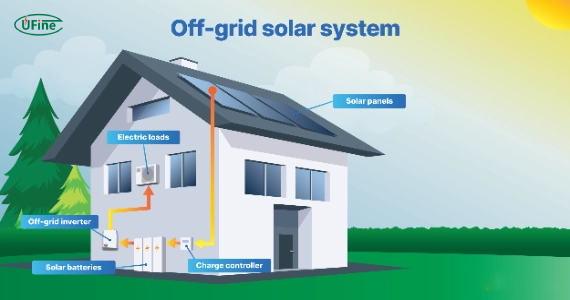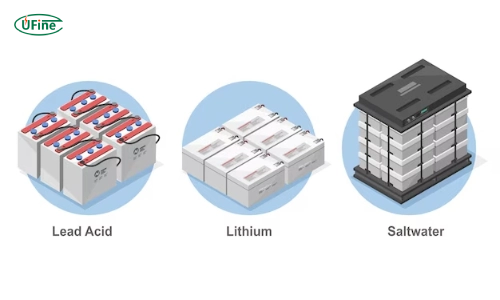Living off the grid has become famous for many seeking independence and sustainability. One crucial component of a successful off-grid system is the battery. Choosing the best batteries for solar off-grid systems can be daunting, given the variety of options available. This guide will walk you through everything you need to know to make an informed decision.
Part 1. Understanding solar off-grid systems
Before diving into the specifics of batteries, it’s essential to understand what a solar off-grid system entails. Unlike grid-tied systems, off-grid systems operate independently of the utility grid, relying entirely on solar panels and batteries to provide electrical power.
Importance of Batteries in Off-Grid Systems
Batteries are the heart of any off-grid solar system. They store the energy the solar panels generate during the day and provide power when the sun isn’t shining. Choosing the correct battery ensures you have reliable power whenever needed.
Part 2. Types of batteries for solar off-grid systems
There are several types of batteries you can use for solar off-grid systems. Each has its advantages and disadvantages. Here are the most common types:
Lead-Acid Batteries
Lead-acid batteries are the most traditional type used in off-grid systems. They come in two main varieties: flooded lead-acid (FLA) and sealed lead-acid (SLA) batteries.
Flooded Lead-Acid (FLA) Batteries
FLA batteries are known for their affordability and reliability. However, they require regular maintenance, including checking water levels and equalizing charges.
Sealed Lead-Acid (SLA) Batteries
SLA batteries, including Absorbent Glass Mat (AGM) and Gel batteries, are maintenance-free and less prone to spilling. They are more expensive than FLA batteries but offer convenience and safety.
Lithium-Ion Batteries
Lithium-ion batteries are increasingly popular for solar off-grid systems due to their high efficiency, long lifespan, and low maintenance. They are more expensive upfront but can save money in the long run.
Nickel-Iron Batteries
Nickel-iron batteries are known for their durability and long life. They can withstand harsh conditions and deep discharges but are less efficient than other types and can be costly.
Saltwater Batteries
Saltwater batteries are an emerging technology that offers a non-toxic, environmentally friendly option. They are currently less common and more expensive but have potential for future use.
Part 3. Pros and cons of different solar off-grid battery types
To help you make an informed decision, let’s summarize the pros and cons of each battery type:
Lead-acid Batteries
Pros:
- Affordable initial cost
- Proven technology
- Widely available
Cons:
- Regular maintenance required (FLA)
- Lower DoD and efficiency
- Shorter lifespan compared to lithium-ion
Lithium-ion Batteries
Pros:
- High efficiency and DoD
- Long lifespan
- Low maintenance
Cons:
- Higher upfront cost
- Requires a compatible battery management system
Nickel-iron Batteries
Pros:
- Extremely durable
- Long lifespan
- Can handle deep discharges
Cons:
- Less efficient
- High cost and heavy
Saltwater Batteries
Pros:
- Environmentally friendly
- Non-toxic
- Safe and stable
Cons:
- Higher cost
- Limited availability and support
Part 4. Factors to consider when choosing the best batteries for solar off-grid
When selecting the best batteries for your solar off-grid system, consider the following factors:
Battery Capacity
We measure battery capacity in ampere-hours (Ah) or kilowatt-hours (kWh). It indicates how much energy the battery can store. To determine the suitable capacity, calculate your daily energy consumption and ensure the battery can meet your needs.
Depth of Discharge (DoD)
The depth of discharge refers to the percentage of the battery’s capacity that can be used without damaging it. A higher DoD means more usable capacity. For example, lithium-ion batteries typically have a higher DoD than lead-acid batteries.
Cycle Life
Cycle life is the number of complete charge and discharge cycles a battery can undergo before its capacity degrades significantly. Batteries with a longer cycle life, such as lithium-ion, are more cost-effective.
Efficiency
Battery efficiency is the percentage of energy stored in the battery that can be retrieved. Lithium-ion batteries are known for their high efficiency compared to lead-acid batteries.
Temperature Tolerance
Consider the temperature tolerance of the battery, especially if you live in an area with extreme temperatures. Some batteries, like lithium-ion, perform well in various temperatures. In contrast, others, like lead acid, may require temperature regulation.
Maintenance Requirements
Maintenance is another crucial factor. Lead-acid batteries, particularly FLA types, require regular maintenance. If you prefer a low-maintenance option, consider sealed lead-acid or lithium-ion batteries.
Cost
Cost is always a consideration. While lithium-ion batteries are more expensive upfront, their long lifespan and efficiency can make them more economical. Lead-acid batteries have a lower initial cost but may require more frequent replacements.
Part 5. How do you calculate your off-grid battery needs?
Calculating your battery needs is essential for designing an efficient off-grid system. Follow these steps to determine the correct capacity:
- Assess Your Energy Usage: List all the appliances and devices you plan to power and their wattage.
- Calculate Daily Consumption: Multiply the wattage of each device by the number of hours you use it per day to get the daily watt-hour (Wh) consumption.
- Determine Total Daily Consumption: Add up the daily Wh consumption of all devices.
- Account for Efficiency Losses: Factor efficiency losses by multiplying the total daily consumption by 1.2 (for 20% efficiency loss).
- Calculate Battery Capacity: Divide the adjusted daily consumption by the voltage (usually 12V, 24V, or 48V) to get the required ampere-hours (Ah).
Part 6. Tips for maximizing off-grid battery life
To get the most out of your batteries, follow these tips:
Regular Maintenance
If you use lead-acid batteries, perform regular maintenance, including checking water levels and equalizing charges.
Avoid Deep Discharges
Avoid discharging batteries below their recommended DoD to prolong their lifespan.
Temperature Control
Keep your batteries in an environment with stable temperatures to enhance their performance and longevity.
Proper Charging
Ensure you charge your batteries correctly using a compatible charge controller to avoid overcharging or undercharging.
Part 7. FAQs
-
What are the environmental benefits of using solar off-grid systems?
Solar off-grid systems reduce reliance on fossil fuels, lowering greenhouse gas emissions. They use clean, renewable energy, minimizing pollution and helping combat climate change. Additionally, they preserve natural landscapes by reducing the need for extensive power grids. -
How long do solar off-grid batteries last?
Lead-acid batteries typically last 3-5 years, while lithium-ion batteries can last up to 10 years or more. Nickel-iron batteries often exceed 20 years. Proper maintenance and correct charging practices can extend battery life significantly. -
Can I expand my solar off-grid system later?
You can expand your system by adding more solar panels and batteries. Ensure your existing components (charge controller, inverter) can handle the increased load. Match new batteries to existing ones in type and capacity for optimal performance. -
What are the safety considerations for solar off-grid batteries?
Ensure proper ventilation to avoid gas buildup, especially with lead-acid batteries. Use protective enclosures to prevent short circuits. Regularly inspect and maintain batteries. For lithium-ion, use a battery management system (BMS). -
How do I dispose of old solar off-grid batteries?
Recycle lead-acid batteries at designated recycling centers. Dispose of lithium-ion batteries through e-waste programs. Never throw batteries in regular trash due to hazardous materials. Check for manufacturer take-back programs for responsible disposal.
Related Tags:
More Articles

How to Choose the Best Floor Scrubber Battery for Commercial Cleaning?
Selecting the ideal floor scrubber battery ensures a long runtime, rapid charging, and minimal maintenance for efficient commercial cleaning operations.
Battery for Blower vs Battery for Leaf Vacuum: Which One Should You Choose?
Battery for blower vs leaf vacuum—learn the key differences in power, fit, and runtime to choose the right battery for your outdoor tool needs.
How to Choose the Right Battery for Blower?
Choosing the right blower battery? Consider voltage, capacity, chemistry & usage. This guide helps match the best battery for peak performance.
How to Choose the Best Insulated Battery Box for Lithium Batteries?
Choosing the Best Insulated Battery Box for Lithium Batteries? Discover key factors such as size, material, and safety for optimal protection and performance.
7 Critical Elements on a Lithium Battery Shipping Label
What must be on a lithium battery shipping label? Learn 7 key elements to ensure safety, legal compliance, and correct handling across all transport modes.





